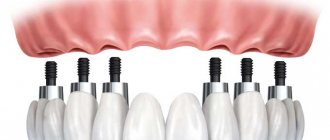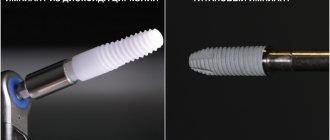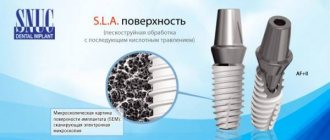A wide variety of materials and devices are used in dentistry. Dental implants have found wide application. They effectively replace the missing part of the body and restore a lost tooth. Technologies related to human health do not stand still. The new materials used help to perform the prosthetic procedure less painfully, quickly, with very high quality and reliability. Zirconium implants have occupied a special niche in the field of prosthetics. Why, let's try to figure it out.
Zirconium crowns – in what cases can they be placed on implants, characteristics, prices
Article navigation
- Zirconium crowns - what are they?
- Classification
- Popular and quality brands
- Indications for use
- What are the contraindications?
- Manufacturing stages
- How is the implant installed?
- Advantages
- Disadvantages of zirconium crowns
- Prosthesis service life
- Rules for caring for dentures
- Patient reviews
- Price
question to a specialist
Dental crowns made of zirconium dioxide today are the best option for prosthetics.
Because they are distinguished by reliability, durability and excellent external characteristics. Zirconium prostheses successfully combine “metallic” strength and natural appearance. Further in the article we will talk about the features of zirconium dioxide crowns on implants - advantages and disadvantages, indications, installation methods and care rules.
Zirconium crowns – what are they?
Gradually, the usual metal-ceramic dental crowns are being replaced by a new generation of materials - in particular, zirconium dioxide (it contains only zirconium and oxygen). This is metal-free ceramics - however, not the usual fragile and snow-white porcelain, but a material that is incredibly durable. This is facilitated by the presence of the parent metal zirconium. Although the dioxide of this metal is white in color and does NOT possess important original “metallic” characteristics - luster, malleability and ductility, high thermal and electrical conductivity. That is, it is dioxide that is no longer a metal, and therefore it has no properties.
It is interesting that in ordinary ceramics (for dentures and other things) there are also metals that are part of the material. These are aluminum and potassium. And the very term “metal-free ceramics” in relation to zirconium dioxide means a method of making a crown - when the zirconium dioxide base is covered with ceramic mass on top for better aesthetics, but, as is clear from the term, there is no metal in the composition. Although we repeat that dioxide is not a metal or a ceramic. That is, in relation to this material it is more correct to say “metal-free crowns”.
Dental implantation using the Osstem system = 70,000 rubles.
All inclusive, treatment guaranteed!
Premium implants at an affordable price. Free consultation with an implantologist +7 (495) 215-52-31 or write to us
Modern dentistry and zirconium dental crowns
Zirconium dental crowns do not contain metal, but remain highly durable. This gives them many advantages over metal-ceramic and all-ceramic structures.
- Zirconium crowns can be placed on both the front and side teeth: they can easily withstand the chewing load, while looking as natural as possible.
- Zirconium crowns are lightweight and do not create excessive load if it is necessary to install a long bridge supported by the patient’s own teeth. At the same time, such prostheses do not require such careful grinding of the tooth before installation - they are an order of magnitude thinner than their metal-ceramic counterparts.
- Zirconium has antibacterial properties, and this is especially important for protecting your own teeth from caries and destruction.
- Zirconium dental crowns are hypoallergenic and highly biocompatible, therefore they are absolutely safe for the body.
By visiting the doctor just once, you can not only discuss the details of prosthetics taking into account personal preferences, but also see the final result thanks to 3D computer visualization.
Classification of zirconium crowns
- double-layer or classic: this type is lined with several layers of ceramic, which gives natural translucency, applied over a zirconium “cap”. Moreover, ceramics are better painted in different shades (than pure dioxide), so it looks more aesthetically pleasing,
- monolithic: made only of zirconium oxide, without lining with additional materials - this increases strength by 200% (compared to the previous type). They are placed mainly on chewing teeth, where the load is many times greater than in the “smile zone”. Monolithic zirconium dentures can be snow-white or even yellowish so as not to stand out from the rest of the dentition.
Manufacturing procedure
The process of manufacturing a zirconium implant is fully automated. Thanks to special production technology, very precise zirconium devices are obtained. Manufacturing consists of two stages:
- First stage: making the frame on a milling machine. The material used is zirconium oxide.
- Second stage: applying a ceramic coating to the manufactured frame.
During manufacturing, a previously taken impression is used, which is scanned. Using an impression, a three-dimensional model is created in virtual space, from which the implant is subsequently manufactured.
Popular and quality brands
The material is considered one of the most difficult to manufacture, and only large companies can and can produce truly high-quality workpieces (zirconium dioxide blocks and disks). Among the brands and brands popular among dentists are the following:
- IPS e.max from Ivoclar Vivadent (but not ceramics, namely zirconium blocks - ZirCAD and ZirPress models). This company also develops pressed ceramics for restorations,
- Prettau from Zirkonzahn is a relative newcomer in the field of prosthetics, allowing you to create innovative crowns without ceramic veneering,
- Zirconia Meso from CEREC.
Indications for use
- single restoration of missing teeth: when you need to install only 1-2 implants,
- suitable for restoring anterior teeth: due to high aesthetics,
- suitable for restoring chewing teeth: due to high strength,
- use in bridges on implants: more than 3 crowns in a row,
- use in prostheses designed for the entire jaw - for example, for implantation with immediate loading. But only as a second stage of prosthetics (on an ongoing basis, since the material is expensive and lasts a very long time), that is, after the implants have completely engrafted and the bite has been normalized.
Naturally, in addition to installing it on an implant, a zirconium dioxide crown can also be placed on a living tooth, even if only its root is preserved.
Implant: why install?
Let us note right away that an implant and a denture are far from the same thing. The implant is only part of the prosthesis. It looks like an ordinary metal rod, which performs the main function of replacing the tooth root. It is implanted into the area of the lost tooth and is considered the basis for further prosthetics. In this case, one implant is installed for each lost tooth.
It is not always the case that a crown is placed on an installed implant, that is, a lost tooth is completely restored. Very often, a rod is implanted for further use as a support for removable dentures. In addition, implants are used if bridges cannot be made.
During prosthetics, a dismountable or non-separable implant can be used. Thus, a non-separable (otherwise called standard) implant is a metal rod presented in the form of a single integral structure. Standard implants make it possible to restore several incisors and molars at once. Such “pins” are most widespread.
A non-separable implant has several parts (in the standard form they are connected into a single whole): screw, crown, abutment, former, plug. In a collapsible design, all these parts are represented by separate elements.
In modern dentistry, noble metals are used to make implants: titanium and zirconium. While titanium structures have been used for many years, zirconium implants have come into the dental field recently.
What are the contraindications?
There are no direct contraindications to the installation of zirconium prostheses[1] - because the material does not provoke allergies or irritation. But there may be contraindications to installing an implant. This primarily includes serious diseases that weaken the body - cardiovascular, endocrine, and oncological. Also, implants cannot be placed in people with increased tone of the masticatory muscles, tuberculosis, poor blood clotting, or decompensated diabetes mellitus.
Read on the topic: who can and cannot get implants - a complete list of indications and contraindications.
Stages of manufacturing a zirconium prosthesis
The production of dental crowns from zirconium dioxide requires CAD/CAM technologies - special software (software) and equipment that will allow you to process the initially hard material and create the ideal product. Zirconium prostheses are not produced manually. In general, the manufacturing process is as follows:
- taking impressions: for this purpose, not the usual “physical” impression can be used, but its “digital” analogue. We are talking about an intraoral 3D scanner, which is capable of scanning both dentitions, abutments and adjacent gums in 2 minutes. Moreover, not only the anatomical features are “remembered”, but also the color of the remaining teeth - to make it more convenient to select the shade of artificial crowns,
- final development of the future prosthesis: the data from the treatment plan and digital “casts” are correlated in the computer. In this case, the program evaluates the patient’s bite and the position of all contacting teeth. Modern programs are capable of independently modeling a prosthesis, which rarely requires modification by an orthopedist or dental technician,
- production of a dental crown or prosthesis: after developing the optimal virtual model, the data is sent “to print” - here special robotic equipment mills the prosthesis from a zirconium block or disk,
- fixation of a zirconium dioxide crown: the doctor himself installs the finished prosthesis on the implant.
You can evaluate the quality of the restoration with a zirconium dioxide crown on an implant by referring to the following photo. The difference between a denture and a natural tooth is not visible.
How is the implant installed?
The stages of installing a zirconium dioxide dental crown on an implant (or rather, on an abutment) can be carried out using two technologies:
- cement fixation: the oldest method, which is similar to fixation on a living tooth. The dentist applies cement to the inside of the denture and places it on the abutment; excess cement is removed. The technology is quite simple, but it will not be possible to remove such a prosthesis without some effort (and sometimes even without destroying or sawing it),
- screw fixation: a modern method that allows you to repeatedly remove and fix the prosthesis if necessary. But there are some subtleties here. For example, even at the moment of milling the product, you need to create a small hole in it through which a screw will be screwed in (this screw also passes through the corresponding hole in the abutment). From the outside, the screw and hole in the crown will be masked with a composite material (analogous to a filling). This option is more preferable because the crown can be removed without damaging all elements. For example, to carry out deep hygienic cleaning or restoration of tissue around the implant if inflammation has occurred.
To understand how a zirconium dioxide crown is installed, we suggest watching the following video.
Benefits of Dental Crowns
- long service life: about 20 years,
- very quick adaptation of the patient to the prosthesis,
- the highest strength and preservation of the shape of the prosthesis,
- excellent aesthetics of the restoration: this confirms the homogeneous shade transition between crown and abutment. That is, an abutment made of any material does not shine through the material of the prosthesis,
- resistance to dyes: food, cigarette smoke,
- perfect fit of the prosthesis: there are no even microscopic gaps, thanks to the production of prosthetics using CAD/CAM systems,
- absence of allergic reactions: since the material is bioinert (does not react with the human body),
- possibility of prosthetics in patients with bruxism.
Zirconium implants are...
The described implants are made of zirconium oxide, which is quite durable in its qualities. The material used is 100% compatible. Such an implant is often prescribed and installed in patients with painful perceptions of foreign implantation.
A zirconium implant has a white color, which is almost similar to the shade of natural teeth. Often these pins are used to restore front teeth, which are very visible when the mouth is open. Titanium pins, at a certain angle and lighting, can be seen through the crown of the tooth, which cannot be said about zirconium ones.
Zirconium implants are used mainly in the following cases:
- The need to install a structure in the form of a bridge.
- Serious contraindications to other methods of dental restoration.
- Installation of prostheses.
- The use of implantation is necessary according to indications.
- One lost tooth needs to be restored.
- Restoration of a large group of teeth. Moreover, the implantation procedure does not depend on the location of the lost teeth.
Pros of zirconium implants
- The risk of various complications is minimal.
- No need to mask the pin. It will not show through the crown of the tooth and the gum mucosa.
- After implantation, you can almost immediately put stress on your teeth. This became possible due to the instantaneous stability of the structure.
- If the patient experiences a severe allergy to metal, then a zirconium implant will not cause such a complication.
- The material from which the implant is made will retain its original properties and characteristics for a long time.
- These implants can be installed even with periodontal disease.
- The created border between the installed crown and the gum is completely invisible.
- Excellent strength characteristics.
- The best aesthetic indicators.
- The implant will not shrink even after a long time.
- The installation procedure does not require extensive grinding of the teeth.
- Such implants and crowns reduce the occurrence of unpleasant irritations and caries to zero.
- Zirconium dioxide implants are completely safe to use. The chemical and physical properties of the material do not allow the body to repel the implanted material.
- The absence of metal in the structure has a positive effect on the health of bone tissue.
- The prosthesis material has low thermal conductivity.
- Externally, the zirconium structure is very similar to a natural tooth.
- The material has good antimicrobial properties.
- Pleasantly long service life: 15 years.
The described devices are especially suitable for people who are prone to allergies.
Cons and contraindications
- Insufficient knowledge, since the design of this material appeared relatively recently.
- High price.
Zirconium implants have contraindications for installation despite the impressive list of advantages. It is not advisable to use these devices if you have:
- pregnancy;
- deep bite;
- bruxism.
Rules for caring for dentures
You shouldn’t think that if dentures last 20 years, look natural, are strong and durable, then you don’t need to take care of them. This is a misconception, since artificial teeth also need to be thoroughly cleaned of plaque and bacteria twice a day, and the mouth should be rinsed after eating food. In addition, in addition to teeth, in the oral cavity there are gums and a tongue, on which harmful bacteria also constantly accumulate.
To make dentures and the surrounding teeth look as attractive as possible, you must not forget about regular visits to the dentist. You need to visit a doctor (even two – an implantologist and a hygienist) 1-2 times a year for a preventive examination and comprehensive oral hygiene.
Postoperative period
During this period, the patient must be prescribed antibiotics and painkillers. In addition, the doctor talks about the following mandatory visits, which are usually prescribed for the first, third and seventh month. You should definitely visit a doctor if you feel unwell or have other alarming symptoms. During your visit, your doctor may order a repeat x-ray.
During this period and beyond, it is necessary to carefully care for your teeth. Be sure to use paste and a brush. In this case, the brush must be made of a material that cannot damage the surface of the dentures. Ceramic and metal-ceramic dental prostheses are considered lightweight and easy to care for. They are not afraid of abrasive substances and are easy to clean.
After installation, complaints of increased tooth sensitivity and unpleasant discomfort are often heard. These phenomena can be eliminated. To do this, solid foods are removed from the diet for a short time (especially in the first weeks). Wearing night braces is recommended for patients with bruxism. These devices are generally manufactured individually for each patient. Be sure to visit the dentist's office for an examination once every six months. The doctor’s final recommendations must be followed.
Patient reviews of zirconium prostheses
You can find reviews about everything on the Internet, but it’s almost impossible to find negative reviews about dental crowns made of zirconium dioxide on implants. This is explained by the high quality of prosthetics and the person’s general satisfaction with the comfort of their life - the smile is beautiful, you can eat whatever you want, pain does not bother you. The disadvantages mainly relate specifically to the work of doctors - if any mistakes were made at the stage of prosthetics.
“Dental problems have plagued me since school. I treated pulpitis in the 5th tooth several times, but after some time it began to hurt again until it broke and I had to pull it out. I went to a prosthetist, but the bridge didn’t suit me; I didn’t want to spoil the neighboring teeth. Then they already offered to put an implant and a zirconium crown on it. Of course, such prosthetics are expensive in terms of price, but I wanted to solve the problem once and for all.”
Anastasia, review from otzovik.com
“For a long time, instead of two front teeth, there were metal-ceramic crowns on implants. But for some reason, no one warned me before the prosthetics that the gums around them would turn blue - what a spectacle. In general, I’m already determined to change them to something more modern. The dentist advised me to use zirconium ones, saying that they are the most durable and the gums will be of normal color.”
Sergey, Irkutsk, review from the website stomatology.rf
Installation process
The process of installing zirconium implants is, as usual, a sequence of actions:
- Consultation and anamnesis. At this stage, the patient and doctor are fully informed about their joint matter. Here it is very important to collect the maximum amount of information about the patient’s health characteristics. During this stage, possible contraindications to the procedure are assessed. The doctor carefully examines the patient’s oral cavity and draws conclusions about the type of implant that will be installed there. In addition, the doctor must consult with the patient and discuss any questions that may arise regarding the procedure and other subtleties.
- Secondary appointment, x-ray, cleaning. This stage is necessary to obtain information about which teeth will need to be treated before installing zirconium implants. Next, the doctor sends the patient for professional oral cleaning. This is a necessary procedure in which all unnecessary deposits are removed. Their presence will certainly lead to undesirable complications during surgery.
- Anesthesia. The implant is installed under anesthesia performed by an anesthesiologist. The responsibilities of the anesthesiologist include determining the patient's contraindications to anesthesia. If they are detected, doctors will not perform surgery. The implant is implanted under local anesthesia. It is very important to determine the dosage correctly. The dose of the administered medication depends on the gender, height, age and weight of the patient.
- Implantation procedure. Initially, the doctor cuts the gum and opens a passage to the bone tissue. After this, drilling of this tissue begins. It is very important here that the diameter of the drill is slightly smaller than the diameter of the implant itself. This will allow the pin to be firmly and securely fixed in the bone tissue. The grooves on the product also contribute to this. It is important to treat the bone tissue and the drilled hole in it with an antiseptic. An implant is inserted into the drilled hole. The edges of the cut gums are sutured. To stop minor bleeding, a cotton swab is placed in the patient's mouth.
Possible complications
The design itself and the procedure for its implantation can cause some complications. Since the material has been little studied, a small risk of danger after surgery remains.
Mistakes made during surgery will undoubtedly lead to subsequent complications after it. In this case, serious health problems are guaranteed. Typically, incorrect installation causes the following symptoms: headache, fever, toothache.
The implant healing stage lasts a very long time: 4 months (lower jaw) and 6 months (upper jaw). During these periods, teeth hurt and ache.
The entire postoperative and rehabilitation period must be strictly visited by a dentist. He will monitor the healing process. This is usually already included in the cost of installing the implant and crown.
It is almost impossible to remove a previously installed implant. It is so implanted into the bone tissue that it becomes part of it.
Cost of prosthetics on implants
How much does a zirconia crown cost for an implant? The price of the crown itself is about 30-35 thousand rubles. If the future patient is interested in the combined price of implantation and prosthetics, then everything will also depend on the price of the implant. For example, the total cost of “turnkey” dental restoration with implants in the middle price segment is about 60 thousand rubles (the price of a zirconium crown is already included here). Implantation and prosthetics on premium models will cost 100-120 thousand rubles - this is for the restoration of 1 tooth. If you need to make a segment of teeth, then multiply the cost of restoration by the number of defects in the row.
[1] Abolmasov N. G., Abolmasov N. N., Bychkov V. A., A. Al-Hakim “Orthopedic dentistry”, M., 2003 - 496 p.
Author: Chernov A. R. (Thank you for your help in writing the article and the information provided)










